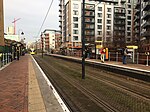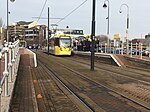Ordsall Hall

Ordsall Hall is a large former manor house in the historic parish of Ordsall, Lancashire, England, now part of the City of Salford, in Greater Manchester. It dates back more than 750 years, although the oldest surviving parts of the present hall were built in the 15th century. The most important period of Ordsall Hall's life was as the family seat of the Radclyffe family, who lived in the house for more than 300 years. The hall was the setting for William Harrison Ainsworth's 1842 novel Guy Fawkes, written around the plausible although unsubstantiated local story that the Gunpowder Plot of 1605 was planned in the house. Since its sale by the Radclyffes in 1662 the hall has been put to many uses: a working men's club, a school for clergy, and a radio station among them. The house was bought by the old Salford Council in 1959 and opened to the public in 1972, as a period house and local history museum. The hall is a Grade I listed building, and entrance is free.
Excerpt from the Wikipedia article Ordsall Hall (License: CC BY-SA 3.0, Authors, Images).Ordsall Hall
Ordsall Lane, Salford Ordsall
Geographical coordinates (GPS) Address Phone number Website External links Nearby Places Show on map
Geographical coordinates (GPS)
| Latitude | Longitude |
|---|---|
| N 53.4693 ° | E -2.2776 ° |
Address
Ordsall Hall
Ordsall Lane 322
M5 3AN Salford, Ordsall
England, United Kingdom
Open on Google Maps









